Luchador: Way of the Mask by ForkBanger
Introduction
Original SA post
Time for something that's enjoyable. It'll be a nice change, I think.
Let's look at
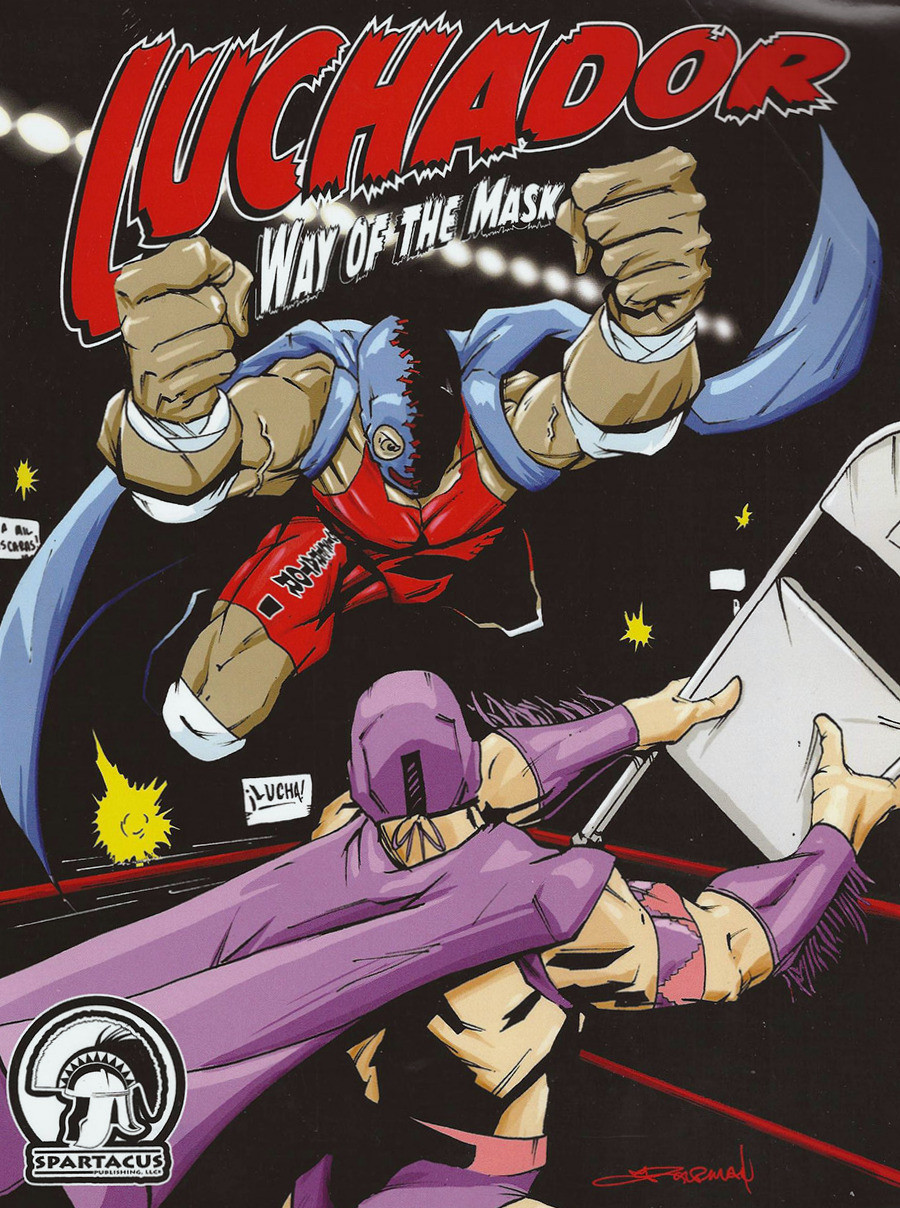
Printed in 2009 by Spartacus Press,
Luchador: Way of the Mask
is 60 pages of fun. How much fun?
Let's see if the back cover has any hints about tha-
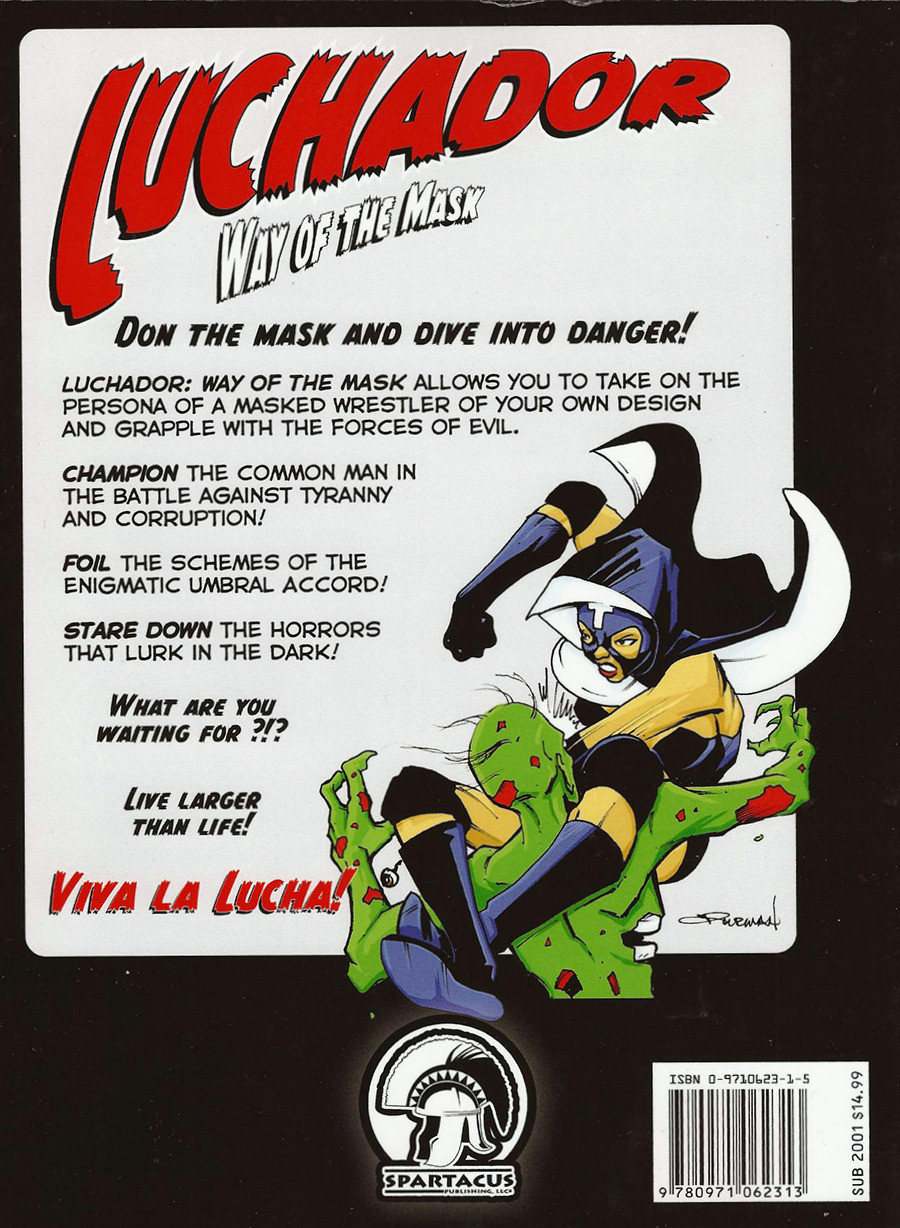
Holy balls, is that a luchador nun wrestling a zombie?
Yes, my friend.
Yes it is.
Let's check the
Intro
and see what's up.
The first paragraph of the book posted:
This game combines our love of masked wrestling and pulp adventure into one action packed package. So, what's the premise? Simple. Players take on the roles of luchadors pitting their high-flying talents against international criminals, secret spy enclaves, evil cults, mad scientists, and other luchadors. Sometimes they will even get to wrestle ach other.
It's that much fun. It's Feng Shui plus Mexican wrestling and it equals awesome . It features Purgatory Cage Matches against horned demons in luchador masks (obviously).
Still the first paragraph of the book posted:
Throughout it all, the characters should embody the flamboyant excitement and code of honor that all uchadores revere. This is not a game for cautious schemers and meticulous tacticians. This is a game for swashbuckling daredevils who know every adventure should end in a free-for-all-battle royale.
Suggestions for things you need to play Luchadore - the gamebook, a d20, familiarity with pro wrestling, and action figures to demonstrate your moves to the GM .
After this brief intro, we get a quick What is Role-Playing/ Gaming Tips section. It's immediately established that it's like playing pretend, but with more rules and less running around, and one person, usually whoever bought the book, will end up being the GM and deciding what the game will involve. Straight away, it's called out as a role that's about getting everyone to enjoy themselves, and including events they will enjoy.
There's a handy little guide to making a basic adventure (figure out your key plot elements, break it down into the main scenes you'd like to see, and come up with the hook to draw characters in), and then more useful advice-
Linear adventures can be boring, so offer multiple leads!
Make up minor scenes of investigation on the fly- you know roughly where you want the players to go, after all.
Don't worry if things don't go the way you intended- consider your options and see what the players are thinking of doing. Don't be afraid to abandon your original plan if their idea sounds interesting.
If they get ahead of your plot, let them .
If the players get lost or freeze up, throw some bad guys at them with a clear lead to the climactic ending.
There's a nice little section about using NPCs, and to remember that the players are the heroes. NPCs should probably lose, and supporting characters should be likable but have some flaw preventing them getting on the action (like not being luchadors, say).
The final pieces of GM advice are to be fair, not play favourites, and keep things moving. The rules are a tool and if you feel you need to check something, don't interrupt the game, check it afterwards.
Wait, what is this, some kind of storygame?
Yes, kind of. posted:
The collective storytelling needs to be a collaboration. If the players don't get involved, the story will wither and die.
Some player advice follows, and it's in much the same vein- sometimes your character won't be in the spotlight; try and be a good supporting character, and let the other PC take center stage. If a PC develops a personal fued with a bad guy, let your buddy have the final confrontation while you handle the henchmen. Provide encouragement if you can- after all, you'll get your time in the spotlight, too.
Finally,
quote:
Whatever you do, don't try to powerbomb your friends through the gaming table.
Next time!
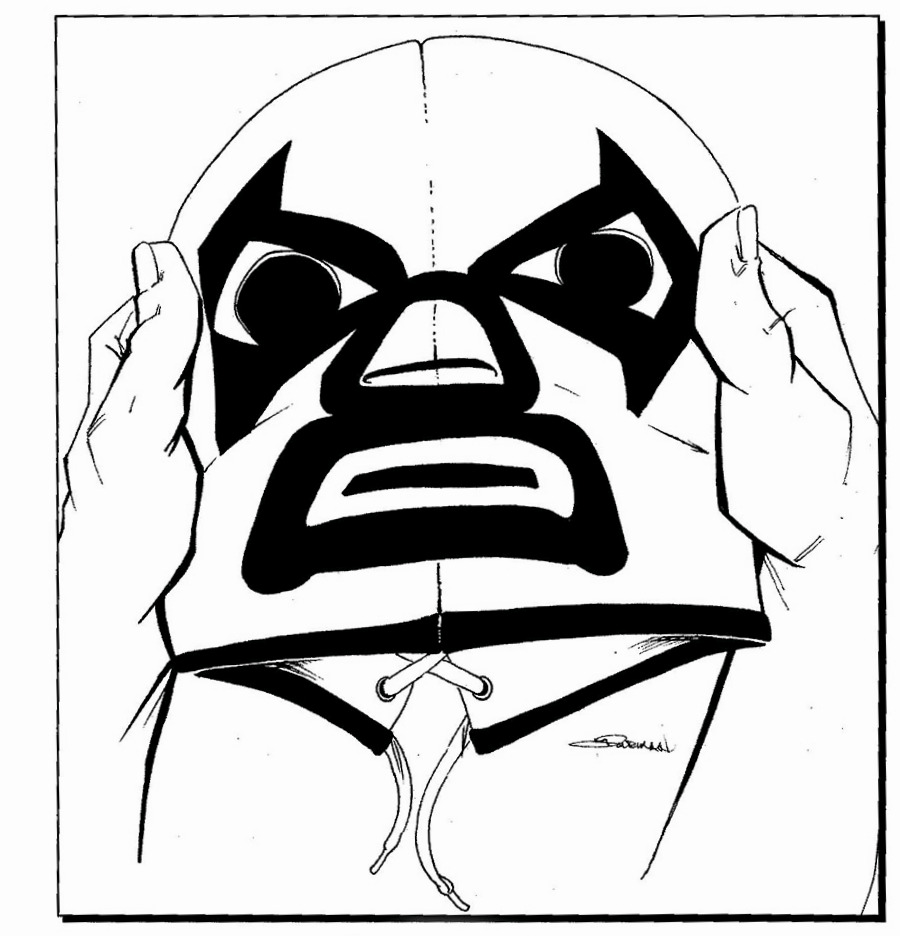
Doing stuff! Making characters!
This might be a good time to suggest names and gimmicks, by the way.
Doing Stuff
Original SA post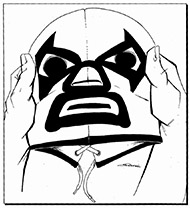
Luchador: Doing Stuff
Let's get down to the nitty gritty of doing stuff - first, some terminology !
When you roll to do stuff, you're performing a check . A strength check is a roll against your strength rating , for instance.
What's a rating ? That's how good you are at something, your score in a statistic or skill .
Each character has six primary statistics - Strength , Agility , Conditioning , Presence , Wits and Determination . More on these next time.
Skills are things you learn. They come in four categories- combat skills , wrestling skills , mike skills , and extracurricular skills . The emphasis is heavily on wrestling skills, with everything else tossed into the extracurricular category. Skill ratings are generally higher than statistic ratings. Again, more next time
Anyway, doing stuff!
Luchador uses a d20 roll-under system- if you roll equal to or under your skill statistic, you succeed. Roll over , and you fail.
There are margins of success ( MoS ) and margins of failure (still MoS , but negative MoS)- the more you beat your Chance of Success , your target number ( CoS ) by, the better your success, and the more you miss it the worse you screw up.
Finally, there's Level of Difficulty ( LoD )- the GM picks a difficulty for tasks, between 0 and 5 , with average actions being 3 .
These margins of success are categorized and titled, and subsequently used as keywords (for example, an exceptional success with a strike threatens to stun your opponent). Here's how things break down-
Disastrous Failure is an MoS of -5 or worse.
Simple Failure is an MoS of -1 to -4.
Simple Success is an MoS of 0 to 4.
Exceptional Success is an MoS of 5 or better.
There are four types of check you might have to roll-
Active checks are deliberate actions with no opposition.
Sewing tassles to your luchadore mask before a match is an active check.
Hasty checks are quick or unprepared actions. In a hasty check, you get +1 LoD , half your MoS if you succeed and double your MoF if you fail( although a disastrous failure doesn't usually make things worse, as hasty checks are usually defensive or reactive).
Spotting an opponent before he jumps out of the crowd and surprises you with a steel chair mid-match is a hasty check.
Free checks are reactive, used for things like resisting stunning after being hit upside your tassled head with a surprise chair.
Opposed checks are used in opposed actions. Both characters make checks, and the winner controls the situation - however, the losers margin of success is subtracted from the winners . If one character succeeds and the other fails, the negative MoS doesn't add to the winners- it has no effect. If both characters fail, they simply struggle fruitlessly.
It's possible that one (or both) character(s) in an opposed check might be making hasty checks.
El Elefante and Flex Romana lock up for a test of strength; each makes a strength check .
El Elefante has a CoS of 8, and rolls 7. His MoS is 1.
Flex Romana has a CoS of 11, and rolls 8. His MoS is 3.
Flex Romana wins, for a total MoS of 2 (Flex Romana's 3 minus El Elefante 1).
The last general sytem bit is Re-Rolls . You can re-roll if an ability allows you to do so, but no backsies- you're stuck with what you re-roll- and you can't re-roll more than once.
That was quite an info-dump, so let's move on to character creation .
It's a four-step process-
1)choose a class
2) roll primary stats, calculate secondary stats
3) buy skill points
4) paint your mask and finish
Classes
There are four classes, which reflect wrestling styles-
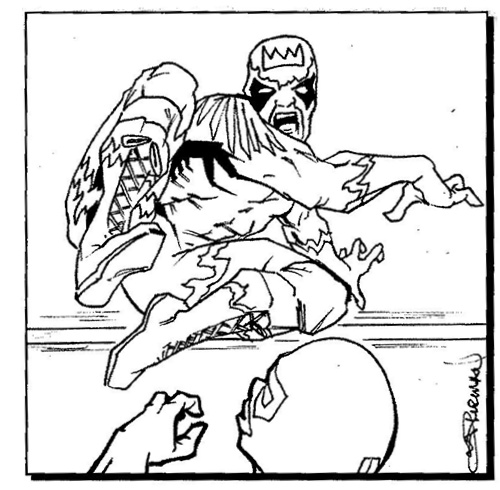
Aerialists are high fliers, who just love jumping off high things onto other luchadors. They get to reroll any agility checks .
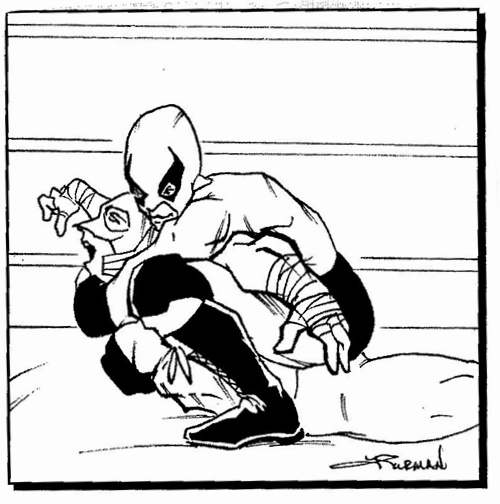
Technicos are masters of mat wrestling and submissions. They get to reroll any wrestling skill checks .
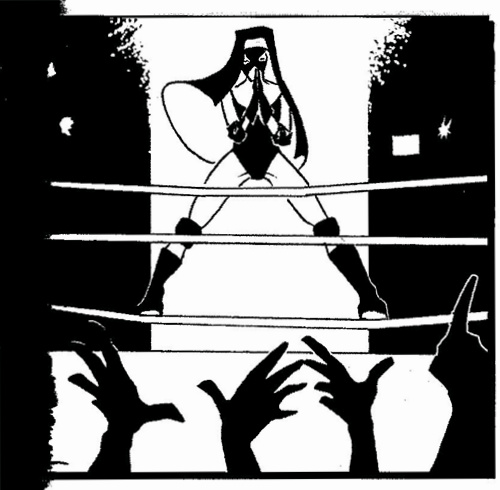
Gimmicos are the most flamboyant luchadores, with an overall theme or image influencing their style. Elaborate masks, flashy posturing and stylish signature moves are what the Gimmico is all about. They get to reroll any Presence checks .
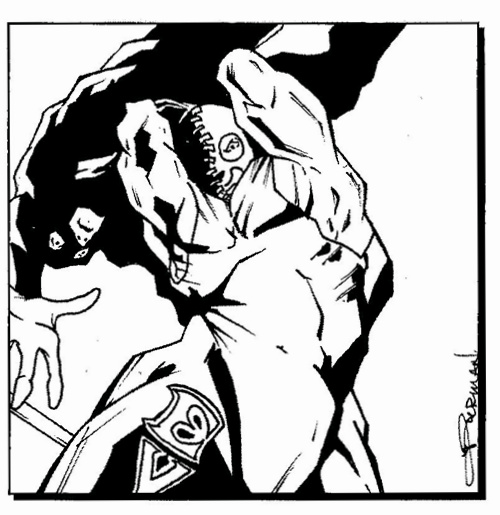
Bruisers are powerhouses and brawlers. They like to punch, slam and overpower anyone who gets in their way. They get to reroll any Strength checks .
Bruiser seems like a good fit for El Elefante , while Technico seems best for Flex Romana .
Stats
Each class comes with a starting stat array; each character makes one check against a rating of 11 for each stat, and modifies the stat based on the result.
Success adds the Mos to the stat.
Simple Failure subtracts 1 from the stat.
Disastrous Failure subtracts 2 from the stat.
If you fail the check, but don't roll higher than the base stat, it remains unchanged.
Finally, you may choose and re-roll one of these checks once you're all done.
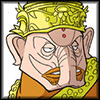 El Elefante
is a
Bruiser
.
El Elefante
is a
Bruiser
.
His base stats are S14 A8 C12 P11 W8 D10
Here's what I roll for him-
code:
Stat Roll MoS
Strength 13 (-2)
Agility 2 (+9)
Conditioning 17 (-6)
Presence 6 (+5)
Wits 8 (+3)
Determination 18 (-7)
El Elefante's stats are now S14 A17 C18 P16 W11 D8 . He's strong, fast, tough and charismatic, but he's not so smart and might have problems if he's locked into a submission hold.
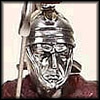 Flex Romana
is a
Technico
.
Flex Romana
is a
Technico
.
His base stats are S11 A11 C12 P11 W11 D12
Here's what I roll for him-
code:
Stat Roll MoS
Strength 20 (-9)
Agility 18 (-7)
Conditioning 8 (+3)
Presence 12 (-1)
Wits 15 (-4)
Determination 9 (+2)
I'll leave Flex Romana's stat re-roll up to you guys, but he won't be hurt too much by his terrible rolls, honest.
Flex Romana's stats are now S9(?) A9(?) C15 P110 W10 D14 . He's questionably strong and agile, slightly bland, but tough and determined.
Sample Luchadors
Original SA post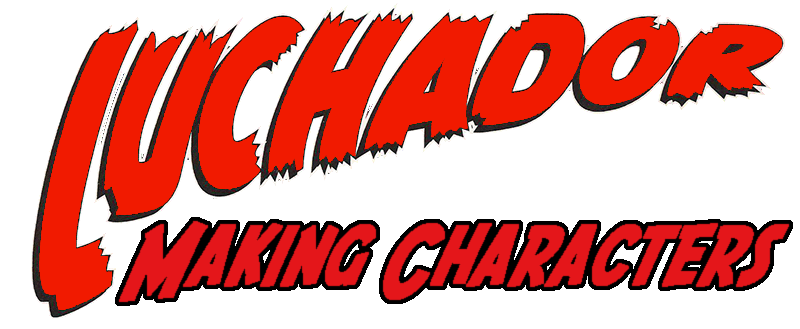
Last time, we were making some sample Luchadors.
Flex Romana uses his reroll on Strength , coming up with 7 . Much better than that 20, leaving him with S15 A9 C15 P10 W10 D14 .
Fuerte Simia is an Aerialist , with base stats of S8 A14 C11 P11 W11 D11 . Seven dice rolls later, his stats are S15 A14 C20 P17 W10 D14 , making him unfeasibly tough and freakishly strong for an Aerialist.
 Mask de Smith
is a
Gimmico
who, due to a spelling error, is an International Man of Mysery. One letter off being a luchador secret agent,
Mask de Smith
settles for finding the cloud around every silver lining.
Mask de Smith
is a
Gimmico
who, due to a spelling error, is an International Man of Mysery. One letter off being a luchador secret agent,
Mask de Smith
settles for finding the cloud around every silver lining.
His base stats are S11 A11 C11 P12 W12 D11 - after some rolling, he's at S14 A10 C10 P13 W15 D19 .
Once you've generated primary stats, you go on to figure some derived stats; each statistic has a rating (used for raw characteristic tests, like lifting stuff) and a level , which is used as a modifier for outcomes. Your level is the stat's rating diovided by 3.
A characters Strength level adds to his damage.
A characters Agility level helps him dodge.
A characters Conditioning level helps soaks damage.
A characters Presence level helps with social interactions.
A characters Wits level helps spot people who are lying to you.
A characters Determination level limits his expertise in skills.
Levels use the short notation of S-level , A-level , C-level , P-level , W-level and D-level .
Once that's done, those levels determine four more stats-
Initiative is 10 + A-level + W-level.
Fatigue is C-level + D-level.
Resilience is S-level + C-level.
Vitality is Resilience x 5.
This is kind of a pain in the ass, but it's all out of the way, at least.
El Elefante ends up with S14(4) A17(5) C18(6) P16(5) W11(3) D8(2), Initiative 18, Fatigue 8, Resilience 10, Vitality 50
Flex Romana ends up with S15(5) A9(3) C15(5) P10(3) W10(3) D14(4), Initiative 16, Fatigue 9, Resilience 10, Vitality 50
Fuerte Simia ends up with S15(5) A14(4) C20(6) P17(5) W10(3) D14(4), Initiative 17, Fatigue 10, Resilience 11, Vitality 55
Mask de Smith ends up with S14(4) A10(3) C10(3) P13(4) W15(5) D19(6),Initiative 18, Fatigue 9, Resilience 7, Vitality 35
Next up, skills . Luchador gives 15 skillpoints to play about with, unless you rolled really well or badly for your stats. You total your MoS for stat rolls- 5 or less, you get +10 skillpoints. Every point above 5 costs you a skillpoint. 15 or higher? You get no skill points.
Let's check our luchadore's total Margins of Success -
El Elefante 16, giving him no skillpoints.
Flex Romana -3, giving him 25 skillpoints.
Fuerte Simia 22, giving him no skillpoints.
Mask de Smith 8, giving him 12 skillpoints.
How do skills work? Well, you're either untrained or proficient , maybe even with some expertise .
If you're untrained , and it's not something you could reasonably do, like open heart surgery, you fail. No surprises there. If it's something you could maybe do, you get to make a hasty skill check using the appropriate characteristic, which limits your success.
If you're proficient , you get a rating in the skill- 10 + half of the governing statistic's rating. When you do your skill stuff, you roll against that. It costs 3 skillpoints or XP to become proficient .
If you're feeling frisky, you can develop expertise in a known skill. Expertise adds 1 to your rating in a skill for each level of expertise; it's not cheap to do, though. +1 expertise costs 1 point, +2 expertise costs another 2 points, +3 expertise costs another 3 points on top of that, and so on. Your expertise is limited by your D-level , so El Elefante's D-level of 2 is going to stop him getting too good at skills, while Mask de Smith's D-level of 6 will let him grow into being awesome.
So, El Elefante and Fuerte Simia have awesome stats, but no skillpoints. Are they doomed to hasty checks and fucking up forever? Hell, no. They're goddamn luchadores, and all luchadores know how to wrestle . Remember how I said skills come in four categories- combat skills, wrestling skills, mike skills, and extracurricular skills? All luchadores are proficient in all skills in the combat and wrestling categories.
I'll give a quick rundown of them now, and detail others later, when we get on to wrasslin'.
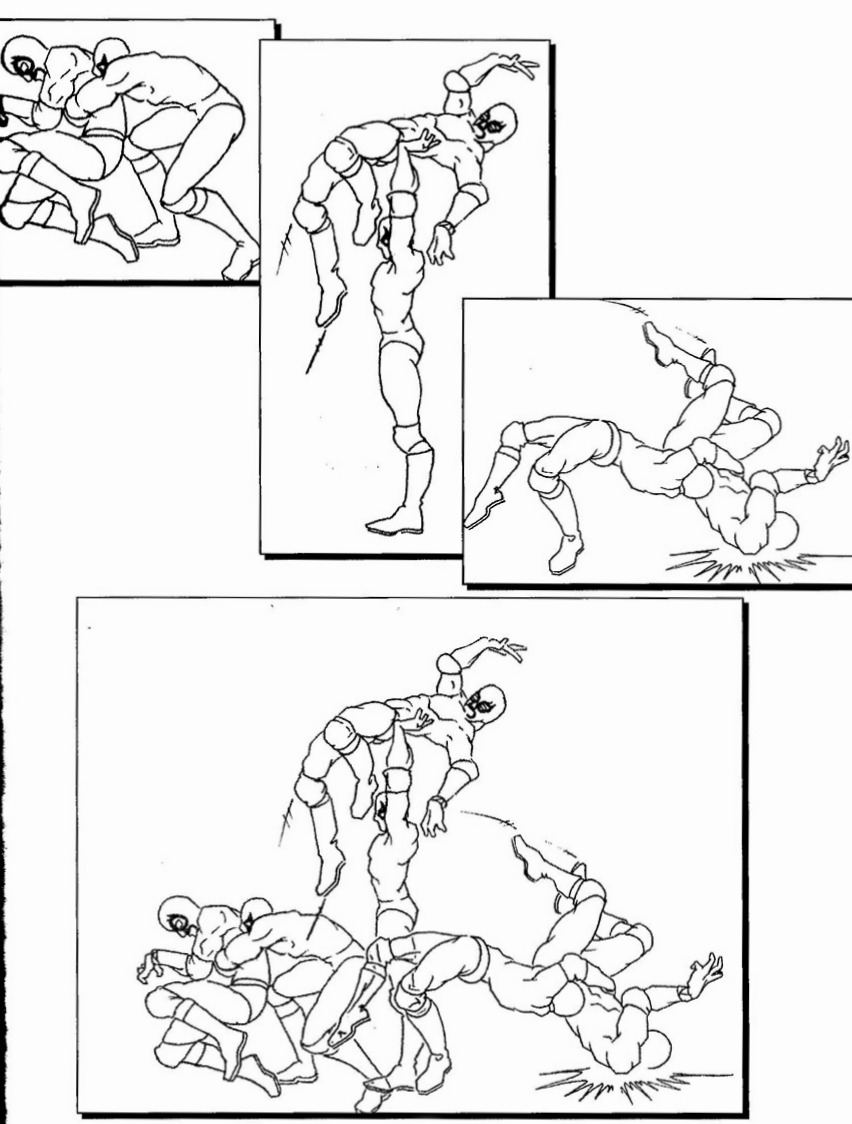
Buy grab and slam, supex all day.
Combat SKills ( all governed by Agility) ) are the punchy kicky basics of lucha action.
Strike - anything that's based around smacking your opponent with part of your anatomy is a strike. Punches, clotheslines, kicks, headbutts, elbow drops- they're all Strikes . Can stun opponents.
Throw - tripping, legsweeps, tosses and faceplants are Throws . Can slow opponents.
Tackle - if you hurl yourself at your opponent, it's a Tackle . Spears, frog splashes and missile dropkicks all count here. They do more damage than regular Strikes , and can stun and/or knockdown your opponent. You also risk putting the 'miss' into 'missile dropkick', which is bad news.
Armed - if you want to hit someone with a chair, you need this. If you don't want to be hit with a chair, you need this. Armed attacks can stun people, but you can't get heat from doing it. This is pretty big, since heat lets you do nifty stuff.
Wrestling SKills come into play when you want to tie your opponent into a human pretzel.
Grab ( Agility ) - a Grab is a basic setup for your moves- a lock-up, or simple hold that stops your opponent going anywhere, before you haul him up and drop him on his head. They don't do any damage, but they stop whoever you snag going anywhere, or doing anything but try to escape.
Hold ( Strength ) - once you've caught someone with a Grab , you might want to make them suffer. Submission moves like figure four leglocks, hammerlocks and full nelsons all use the Hold skill. Holds increase their damage as you maintain them, injure people more easily than other methods, and make a grown luchador cry. Literally.
Slam ( Strength ) - powerbombs, slams and suplexes all fall under the auspices of this skill. Slams do big damage, can stun, and will knock the target prone. You can make your slams more damaging (and risky) by falling prone when you do it. Everyone knows sitting a move out makes it do more damage.
Drop ( Agility ) - DDTs, stunners and bulldogs are all drops. They hurt almost as much as a Slam , they can stun the target, and they get knockdowns pretty easily- but they do leave the attacker prone.
Next time! The other skills! Wrasslin'!
More Skills
Original SA post
We'd started looking at skills- last time, it was the wrestling skills that are the building blocks for doing suplexes and whatnot. This time, we'll cover the other stuff.
Mike Skills are used to influence NPCs, and there are only four of them.
Promo (Presence) lets you get attention, hype a match, or rally people to your cause. It's inspiring, lasting, and can provoke a crowd to take action. You can also use it during a fight, showboating and taunting. Do it right, and you'll increase your fatigue for the duration of the fight as you feed off the crowd's energy, letting you throw out bigger and better moves.
Intimidate (Presence) lets you stare people down. Success makes the target stop aggressive behavior. Exceptional success makes them run the hell away. You can use it in combat, too- succeed, and your opponents will act more hesitantly, losing initiative.
Trick (Wits) is used for dickery, and gives you a brief window of opportunity- it uses uncertainty to grab an advantage, and doesn't hold up to scrutiny. There are two general uses in combat- distraction, and playing possum. Distracting someone makes them momentarily easier to hit. Playing possum can be used to sucker people into doing something stupid- like climbing a turnbuckle, for instance.
Beg (Presence) is 'the most distasteful of mike skills'. It's used for sucking up, or for covering somebody's total lack of social graces. In combat, you can drop prone and beg for mercy. Do it right, and your opponent pauses while you remain prone and begging. Do it wrong, and you've dropped prone in front of a furious wrestler, and cried like a girl in front of the crowd. Oops.
The last of the skill categories is Extracurricular Skills . This covers all things non-wrestling. Luchadore doesn't bother with listing them, just provides a handful of categories and shrugs. Nobody gives a shit if your luchadore knows about basket-weaving.
Languages . Every luchadore speaks Spanish. Each language skill lets you get a new language. You only test language skills under stressful situations, because it's boring otherwise.
Crafts . You can make stuff and try to sell it. You're a luchadore, you make money wrestling. If you wanted to make a carpenter and roleplay making tables, you've picked the wrong game. In this one, you put people through tables.
Knowledge . Well done, you know stuff.
Pilot . Driving/flying/sailing/whatever. You only roll if you're doing something dramatic, like trying stunts or having a car chase.
That's it for skills!
Pick some for our sample characters, if you like!
Next time! Putting it all together!